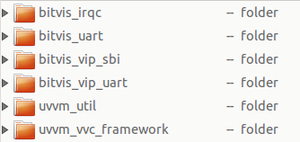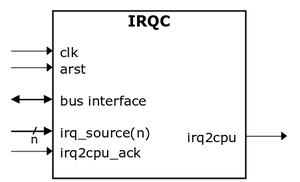Bitvis UVVM VHDL Verification Component Framework: Difference between revisions
No edit summary |
No edit summary |
||
| Line 329: | Line 329: | ||
The above call checks if the signal irq2cpu is 'X', and obviously fail if everything works correctly and gives the following message: | The above call checks if the signal irq2cpu is 'X', and obviously fail if everything works correctly and gives the following message: | ||
[[File:error.png| | [[File:error.png|600px]] | ||
Revision as of 13:03, 28 January 2016
-- Copyright (c) 2016 by Bitvis AS. All rights reserved. -- You should have received a copy of the license file containing the MIT License (see LICENSE.TXT), if not, -- contact Bitvis AS <support@bitvis.no>. -- UVVM AND ANY PART THEREOF ARE PROVIDED "AS IS", WITHOUT WARRANTY OF ANY KIND, EXPRESS OR IMPLIED, -- INCLUDING BUT NOT LIMITED TO THE WARRANTIES OF MERCHANTABILITY, FITNESS FOR A PARTICULAR PURPOSE AND NONINFRINGEMENT. -- IN NO EVENT SHALL THE AUTHORS OR COPYRIGHT HOLDERS BE LIABLE FOR ANY CLAIM, DAMAGES OR OTHER LIABILITY, -- WHETHER IN AN ACTION OF CONTRACT, TORT OR OTHERWISE, ARISING FROM, OUT OF OR IN CONNECTION WITH UVVM. --========================================================================================================================
This wiki page steals heavily from the Powerpoint-presentation found here.
Introduction
Bitvis UVVM VVC Framework is a complete framework for making VHDL testbenches for verification of FPGA and ASIC desing. You can download the complete code-base, examples and simulations scripts from the Bitvis web page.
What's in the folders?

The download includes severals folders:
- bitvis_irqc - example VHDL design + testbench
- bitvis_uart - example VHDL design + testbench
- bitvis_vip_sbi - Verification IP(VIP) for simple bus interface(SBI)
- bitvis_vip_uart - VIP for UART TX and RX
- uvvm_util - UVVM utility library - sufficient for simple testbenches
- uvvm_vvc_framework - Framework for more advanced tutorials
IRQC

The provided example VHDL design is a simple interrupt controller with several internal registers, a bus interface and some input and output signals.
Testbench creation
Copy the folders bitvis_irqc, bitvis_vip_sbi and uvvm_util to another location before editing the files.
Generate TB entity with DUT instantiated
Our TB entity can in many cases be generated from several tools. Notepad++ (among other) supports plugins that enables copying an entity and pasting it as an instantiation, and also as a complete testbench template. However, we will change some of our signals so that they fit the VIP SBI BFM. The signals to and from the CPU will be converted to t_sbi_if record, which is a type that includes all the SBI signals (cs, addr, rd, wr, wdata, ready and rdata).
--Standard libraries
library IEEE;
use IEEE.std_logic_1164.all;
use IEEE.numeric_std.all;
-- Libraries used for string handling in UVVM
library STD;
use std.env.all;
-- Obviously the UVVM library
library uvvm_util;
context uvvm_util.uvvm_util_context;
-- We will use this library later when implementing the Bus Functional Model
-- Includes among much else the record type t_sbi_if and many functions
-- If other buses are used, you will have to change this library
library bitvis_vip_sbi;
use bitvis_vip_sbi.sbi_bfm_pkg.all;
-- This file includes definitions of everything from registers to record types
use work.irqc_pif_pkg.all;
-- Test case entity
entity irqc_tb is
end entity;
-- Test case architecture
architecture func of irqc_tb is
-- DSP interface and general control signals
signal clk : std_logic := '0';
signal arst : std_logic := '0';
-- CPU interface
-- t_sbi_if is from the verification IP SBI
-- init_sbi_if_signals initialize the inputs to 0 and the outputs to Z
signal sbi_if : t_sbi_if(addr(2 downto 0), wdata(7 downto 0), rdata(7 downto 0)) := init_sbi_if_signals(3, 8);
-- Interrupt related signals
signal irq_source : std_logic_vector(C_NUM_SOURCES-1 downto 0) := (others => '0');
signal irq2cpu : std_logic := '0';
signal irq2cpu_ack : std_logic := '0';
begin
-----------------------------------------------------------------------------
-- Instantiate DUT
-----------------------------------------------------------------------------
i_irqc: entity work.irqc
port map (
-- DSP interface and general control signals
clk => clk,
arst => arst,
-- CPU interface
cs => sbi_if.cs, -- NOTICE THE SIGNALS ARE NOW SBI_IF
addr => sbi_if.addr,
wr => sbi_if.wr,
rd => sbi_if.rd,
din => sbi_if.wdata,
dout => sbi_if.rdata,
-- Interrupt related signals
irq_source => irq_source,
irq2cpu => irq2cpu,
irq2cpu_ack => irq2cpu_ack
);
end func;
Add support process for clock generation
We now have to add a support process that controls the clock. This has to allow enabling/disabling from the test sequencer. We add the following before "begin" in our architecture:
-- Added for clock generation
signal clock_ena : boolean := false;
constant C_CLK_PERIOD : time := 10 ns;
procedure clock_gen(
signal clock_signal : inout std_logic;
signal clock_ena : in boolean;
constant clock_period : in time
) is
variable v_first_half_clk_period : time := C_CLK_PERIOD / 2;
begin
loop
if not clock_ena then
wait until clock_ena;
end if;
wait for v_first_half_clk_period;
clock_signal <= not clock_signal;
wait for (clock_period - v_first_half_clk_period);
clock_signal <= not clock_signal;
end loop;
end;
Our clock can now be activated from the test sequencer (this will be added in the next step):
-- After begin in the architecture clock_gen(clk, clock_ena, C_CLK_PERIOD); -- Inside the test sequencer process clock_ena <= true;
Add test sequencer process
The next step is to add the test sequencer process. This process controls everything from initialization to termination of the simulation.
-- Set upt clock generator clock_gen(clk, clock_ena, C_CLK_PERIOD); ------------------------------------------------ -- PROCESS: p_main ------------------------------------------------ p_main : process -- The scope tells you where log messages originates - C_SCOPE tells us they originate from the default test sequencer scope constant C_SCOPE : string := C_TB_SCOPE_DEFAULT; -- This is where we will add some procedures later to simplify the tests begin --Print the configuration to the log report_global_ctrl(VOID); report_msg_id_panel(VOID); enable_log_msg(ALL_MESSAGES); --disable_log_msg --enable_log_msg(ID_LOG_HDR); log(ID_LOG_HDR, "Start Simulation of TB for IRQC", C_SCOPE); ------------------------------------------------------------ clock_ena <= true; -- to start clock generator ------------------------------------------------------------ -- End the simulation wait for 1000 ns; -- to allow some time for completion report_alert_counters(FINAL); -- Report final counters and print conclusion for simulation (Success/Fail) log(ID_LOG_HDR, "SIMULATION COMPLETED", C_SCOPE); --Finish the simulation std.env.stop; wait; -- to stop completely end process p_main;
Simulation
We now have the skeleton of the testbench, which we will develop further. But now, let's see if everything works. Bitvis have created simulation scripts for the IRQC example that compiles everything we need, from the source files of the VHDL design, to the testbench (if you called the file irqc_tb.vhd and placed it in the tb-folder) and the SBI BFM and the UVVM library. Open up QuestaSim/ModelSim. Change directory to the script folder:
cd ~/phys321/bitviswiki/bitvis_irqc/script do compile_and_sim_all.do
This will present our result in the transcript windows, but also write _Log.txt file which includes all the information we have asked for. We see that we get the results from the following code:
report_global_ctrl(VOID); report_msg_id_panel(VOID); enable_log_msg(ALL_MESSAGES); log(ID_LOG_HDR, "Start Simulation of TB for IRQC", C_SCOPE); report_alert_counters(FINAL); log(ID_LOG_HDR, "SIMULATION COMPLETED", C_SCOPE);
Commenting these out will result in an empty log.
Verbosity control
We want to able to control the amount of information in our logs, and the framework enables us to prioritize messages based on ID. This makes it easy to turn on or off the information we want. To turn on a specific ID
enable_log_msg(IDNAME);
Turn off:
disable_log_msg(IDNAME);
For writing a message to a certain log ID:
log(IDNAME, "MESSAGE HERE", C_SCOPE);
Remember that C_SCOPE just tells us that the message originated from the default scope and will look like "TB seq." in the log file.
Exampled IDs:
- ID_LOG_HDR, -- ONLY allowed in test sequencer, Log section headers
- ID_SEQUENCER, -- ONLY allowed in test sequencer, Normal log (not log headers)
- ID_BFM, -- Used inside a BFM (to log BFM access)
- ID_CLOCK_GEN, -- Used for logging when clock generators are enabled or disabled
- ALL_MESSAGES -- Applies to ALL message ID apart from ID_NEVER
You'll find all the different ID's in the UVVM Utility Library Quick Reference or defined in uvvm_util/adaptions_pkg.vhd. This also where C_TB_SCOPE_DEFAULT is defined.
Implement first tests

We want to check and verify that our testbench is up and running and to verify our first tests of the DUT. This means that we have to able to set all our signals passive, apply a reset signal and then check the default outputs of the DUT.
Instead of setting all our signals passive one-by-one in our test sequencer we declare a procedure in our p_main process(this is done before begin):
procedure set_inputs_passive(
dummy : t_void) is --dummy variable is included only to allow calling the procedure with parenthesis for readability
begin
sbi_if.cs <= '0';
sbi_if.addr <= (others => '0');
sbi_if.wr <= '0';
sbi_if.rd <= '0';
sbi_if.wdata <= (others => '0');
irq_source <= (others => '0');
irq2cpu_ack <= '0';
log(ID_SEQUENCER_SUB, "All inputs set passive", C_SCOPE);
end;
Note that the procedure declaration also includes a dummy variable parameter. This means that we will be able to call the procedure with the more readable:
set_inputs_passive(VOID);
Rather than:
set_inputs_passive;
which is more ambigious.
We may also would like to send pulses on different signals, f.ex. sending a pulse on our reset to see if it behaves like intended. We therefore can include a pulse procedure:
procedure pulse(
signal target : inout std_logic_vector;
constant pulse_value : in std_logic_vector;
signal clock_signal : in std_logic;
constant num_periods : in natural;
constant msg : in string) is
begin
if num_periods > 0 then
wait until falling_edge(clock_signal);
target <= pulse_value;
for i in 1 to num_periods loop
wait until falling_edge(clock_signal);
end loop;
else
target <= pulse_value;
wait for 0 ns; -- Delta cycle only
end if;
target(target'range) <= (others => '0');
log(ID_SEQUENCER_SUB, "Pulsed to " & to_string(pulse_value, HEX, AS_IS, INCL_RADIX) & ". " & msg, C_SCOPE);
end;
In the above example the test sequencer is required to inform the procedure of what value the pulse is to take. The call to the procedure would take the following form:
pulse(arst, 'Z', clk, 10, "Log message - Im pulsing the value 'Z'");
But a more specific overload can be created where pulse always takes value '1':
procedure pulse(
signal target : inout std_logic;
signal clock_signal : in std_logic;
constant num_periods : in natural;
constant msg : in string
) is
begin
if num_periods > 0 then
wait until falling_edge(clock_signal);
target <= '1';
for i in 1 to num_periods loop
wait until falling_edge(clock_signal);
end loop;
else
target <= '1';
wait for 0 ns; -- Delta cycle only
end if;
target <= '0';
log(ID_SEQUENCER_SUB, msg, C_SCOPE);
end;
These procedures can now be called directly from our test sequence:
set_inputs_passive(VOID); pulse(arst, clk, 10, "pulsed reset-signal - active for 10T");
To check signal values we can use the built-in check function check_value():
check_value(irq2cpu, 'X', ERROR, "Interrupt to CPU must be default inactive", C_SCOPE);
The above call checks if the signal irq2cpu is 'X', and obviously fail if everything works correctly and gives the following message:


